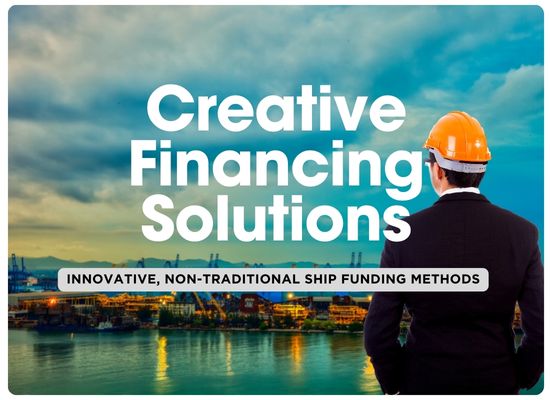Creative Ship Financing: 30 Alternative Paths to Consider

Whether you're looking to purchase a new vessel, retrofit an aging fleet, or embrace green technology, creative financing solutions can open up opportunities you might not have considered. This list of 30 innovative ship financing strategies is designed not only to spark fresh ideas but also to help you discover unconventional paths that align with your unique needs. Explore these concepts and let them inspire additional solutions tailored to your goals.

1. Crowdfunding for Maritime Ventures 🌐
Crowdfunding has revolutionized many industries, and maritime is no exception. Platforms like Kickstarter or dedicated maritime crowdfunding platforms allow shipowners to attract funds from a pool of small investors. By presenting a compelling project—such as a sustainable shipping initiative or a niche ferry service—owners can secure financial backing without hefty interest rates or stringent collateral requirements.
- Best for: Innovative projects with broad public appeal.
- Key benefit: No interest payments; potential for community engagement.
- Why it works: Crowdfunding taps into public enthusiasm and leverages collective funding, making it ideal for projects with clear environmental or social benefits.
2. Revenue-Sharing Agreements 🤝
Instead of taking on debt, shipowners can partner with investors through revenue-sharing agreements. In this model, investors provide the capital needed to acquire or upgrade a vessel, and in return, they receive a percentage of the ship’s revenue for a specified period.
- Best for: Expanding capacity on profitable trade routes.
- Key benefit: Aligns investor and owner interests without increasing liabilities.
- Why it works: Revenue-sharing aligns both parties' goals by tying returns directly to the ship's financial success, reducing risk for both sides.
3. Green Bonds for Eco-Friendly Upgrades 🌿
As the maritime sector faces mounting pressure to adopt sustainable practices, green bonds have emerged as a powerful financing tool. Issued by governments or private entities, these bonds are specifically designed to fund eco-friendly projects, such as retrofitting ships with energy-efficient technologies or switching to cleaner fuels.
- Best for: Sustainability-focused upgrades or new builds.
- Key benefit: Lower interest rates and favorable terms for green projects.
- Why it works: Green bonds incentivize eco-conscious investments and make sustainable upgrades financially viable for shipowners.
4. Blockchain-Enabled Ship Tokenization 🛠️
Blockchain technology allows shipowners to tokenize vessel ownership, dividing it into digital shares that can be sold to multiple investors. This creates a decentralized way of raising capital while offering investors liquidity through secondary markets.
- Best for: High-value vessels or niche projects.
- Key benefit: Increased flexibility for ownership and funding.
- Why it works: Tokenization democratizes ship financing, enabling smaller investors to participate while offering transparency and liquidity through blockchain technology.
5. Peer-to-Peer Lending Platforms 💻
Peer-to-peer (P2P) lending platforms provide a direct connection between shipowners and individual investors willing to fund maritime projects. These platforms often bypass traditional financial institutions, offering more flexibility in terms and faster funding.
- Best for: Small to midsize ship acquisitions or upgrades.
- Key benefit: Streamlined application process and customized terms.
- Why it works: P2P platforms reduce overhead costs associated with traditional lending and attract investors interested in niche opportunities, creating a win-win for both parties.
6. Joint Venture Partnerships 🤝
In this model, a shipowner partners with another business or investor to share the cost and benefits of owning and operating a vessel. Both parties contribute capital and often expertise, splitting the revenue or profits based on agreed terms.
- Best for: High-cost ventures like large cargo ships or offshore support vessels.
- Key benefit: Shared financial risk and access to combined expertise.
- Why it works: Joint ventures enable shipowners to mitigate financial risk while accessing the partner's resources, networks, and knowledge to maximize profitability.
7. Pay-As-You-Earn Financing 🛳️
This innovative model allows shipowners to finance a vessel or upgrade while making payments proportional to their earnings. Payment amounts fluctuate based on revenue, offering financial flexibility during slow seasons or challenging market conditions.
- Best for: Seasonal shipping businesses or startups.
- Key benefit: Payment terms adjust to business performance.
- Why it works: Pay-as-you-earn financing prevents cash flow disruptions, ensuring owners can manage operational expenses while still meeting financing obligations.
8. Maritime Cooperative Funds 🌍
A cooperative fund pools resources from multiple shipowners to finance vessel acquisitions or shared infrastructure. Members of the cooperative contribute to the fund and benefit from collective purchasing power and reduced costs.
- Best for: Smaller fleet owners or cooperative associations.
- Key benefit: Reduced financial burden through shared ownership and expenses.
- Why it works: Cooperative funds harness the power of collaboration, enabling small and medium-sized operators to access financing and resources otherwise out of reach individually.
9. Sale and Leaseback Agreements 🔄
In a sale and leaseback arrangement, a shipowner sells their vessel to an investor or leasing company and then leases it back for a fixed term. This provides immediate cash flow while retaining operational control of the ship.
- Best for: Owners needing quick liquidity without losing operational assets.
- Key benefit: Frees up capital while maintaining access to the ship.
- Why it works: Sale and leaseback agreements allow shipowners to unlock capital tied up in their vessels, offering financial flexibility for expansion or other needs.
10. Shipping Pools 🚢
Shipping pools involve multiple shipowners pooling their vessels to operate as a single entity. Revenue is shared among members based on the performance and contribution of their ships to the pool.
- Best for: Tankers, bulk carriers, or specialized vessels.
- Key benefit: Risk diversification and consistent revenue.
- Why it works: Shipping pools enhance operational efficiency and provide steady cash flow by optimizing fleet utilization and negotiating better freight rates.
11. Pay-Per-Use Financing 📊
This innovative model allows shipowners to pay for the financing of their vessel based on usage metrics, such as voyage hours or cargo capacity utilized. Payments scale with the level of operational activity.
- Best for: Charter services or owners with unpredictable utilization rates.
- Key benefit: Flexible costs aligned with usage.
- Why it works: Pay-per-use financing reduces the financial burden during low-activity periods, making it ideal for owners with seasonal or variable operations.
12. Carbon Credit Financing 🌱
Shipowners investing in environmentally friendly technologies, such as energy-efficient engines or alternative fuels, can generate carbon credits that are sold to other businesses. The revenue from these credits can then be used to offset financing costs.
- Best for: Green-focused shipowners investing in eco-friendly upgrades.
- Key benefit: Monetizes sustainability efforts.
- Why it works: Carbon credit financing creates a dual benefit: reducing environmental impact and generating a new revenue stream to support ongoing sustainability investments.
13. Crowdlending for Maritime Projects 🌟
Crowdlending involves raising funds through online platforms where individuals or institutional investors lend money in exchange for interest payments. Unlike crowdfunding, this method is structured more like a loan.
- Best for: Mid-sized ship purchases or specific retrofit projects.
- Key benefit: Competitive interest rates and no reliance on traditional banks.
- Why it works: Crowdlending provides a scalable solution for shipowners to access capital from diverse investors, often with more favorable terms than conventional loans.
14. Hybrid Financing Models ⚙️
Hybrid financing combines elements of equity and debt financing, allowing shipowners to access both capital injections and loans under a single structure. For example, part of the financing might come as revenue-based equity, while the rest is structured as a low-interest loan.
- Best for: Large-scale projects or fleet expansions.
- Key benefit: Balances risk and cost by diversifying funding sources.
- Why it works: Hybrid models offer flexibility in structuring deals, attracting both risk-tolerant investors and debt-focused lenders.
15. Equipment-Specific Financing ⚓
Instead of financing an entire ship, this approach focuses on funding specific high-value components like engines, thrusters, or navigation systems. Specialized maritime financiers or manufacturers may provide the funds.
- Best for: Vessel upgrades or replacing aging equipment.
- Key benefit: Reduced upfront costs for essential improvements.
- Why it works: By focusing on specific equipment, shipowners can enhance operational efficiency without the financial strain of full vessel financing.
16. Trade Credit from Shipyards 🏗️
Shipyards may offer trade credit to shipowners, allowing them to defer payment for new builds or retrofitting projects over a set period. This type of credit is often tied to long-term supply relationships.
- Best for: New ship construction or significant retrofitting.
- Key benefit: Flexible payment terms and access to high-quality builds.
- Why it works: Trade credit reduces the immediate financial burden and strengthens relationships with shipyards, fostering collaboration for future projects.
17. Convertible Debt Financing 🔄
Convertible debt allows shipowners to raise capital through a loan that can be converted into equity at a later stage, typically upon reaching specific milestones or at the investor's discretion.
- Best for: Startups or shipowners with high growth potential.
- Key benefit: Access to capital with lower initial debt repayment pressure.
- Why it works: This model attracts investors by combining the security of debt with the potential upside of equity, making it ideal for innovative shipping ventures.
18. Charter Financing 🚢
In this model, a charter agreement is used to secure financing, with future earnings from charter contracts serving as collateral. Financing is structured around the expected revenue from the vessel’s operation.
- Best for: Cargo or passenger vessels with long-term charter commitments.
- Key benefit: Leverages predictable revenue streams for funding.
- Why it works: Charter financing reduces risk for lenders and provides shipowners with immediate access to funds based on their contracts' future income.
19. Maritime Crowdsourced Investment Funds 🌐
These specialized investment funds pool resources from multiple investors to finance ships or fleets. Investors receive returns based on the performance of the financed vessels.
- Best for: Small or medium-sized fleets needing diverse investor backing.
- Key benefit: Access to a broad base of investors with shared risk.
- Why it works: Crowdsourced funds democratize access to maritime investments and spread risk across a portfolio of vessels, making it appealing to both shipowners and investors.
20. Deferred Payment Arrangements ⏳
Shipowners negotiate agreements with sellers or manufacturers to delay payment for a vessel or major equipment purchase. Payments are deferred over a specific period, often with low or no interest.
- Best for: Owners upgrading fleets or buying secondhand ships.
- Key benefit: Immediate access to assets with flexible payment schedules.
- Why it works: Deferred payments provide breathing room for shipowners to generate revenue from the asset before paying it off, easing cash flow concerns.
21. Venture Capital for Maritime Startups 🚀
Venture capital firms specializing in maritime innovation invest in shipowners or companies developing cutting-edge technologies or unique business models. In exchange, they receive equity in the business.
- Best for: High-risk, high-reward projects or tech-driven maritime ventures.
- Key benefit: Access to large-scale funding and industry expertise.
- Why it works: Venture capitalists provide not only financial resources but also strategic support, making it a win-win for innovative shipowners looking to disrupt the market.
22. Sustainable Shipping Grants 🌊
Various governments and international organizations offer grants to shipowners investing in sustainable practices, such as low-emission engines, alternative fuels, or eco-friendly retrofits.
- Best for: Green initiatives and compliance with environmental regulations.
- Key benefit: Non-repayable funds for sustainability-focused projects.
- Why it works: Grants lower the cost of environmentally friendly upgrades, encouraging shipowners to adopt sustainable technologies without financial strain.
23. Profit-Sharing Agreements 💸
Under this arrangement, investors provide capital in exchange for a share of the ship’s profits instead of interest or principal repayments. This is often used for high-risk ventures where profits could be substantial.
- Best for: Ventures with unpredictable but potentially high returns, such as exploratory shipping routes.
- Key benefit: Avoids upfront financial burden and spreads risk.
- Why it works: Profit-sharing aligns incentives, as investors and shipowners benefit directly from the ship’s success, making it ideal for speculative or pioneering projects.
24. Tax-Advantaged Leasing Structures 💼
Ship leasing companies or financial institutions offer tax-efficient leasing models, where shipowners can lease vessels while benefiting from tax deductions on lease payments. These models are often customized to the maritime sector.
- Best for: Owners looking to reduce tax liabilities while expanding fleets.
- Key benefit: Lower financial and tax burdens through strategic leasing.
- Why it works: Tax-advantaged leases enable shipowners to preserve capital while optimizing tax efficiency, freeing up resources for operational or growth needs.
25. Equity Crowdfunding 🏗️
Equity crowdfunding allows shipowners to raise capital by selling small ownership stakes in their vessel or shipping company through online platforms. Unlike traditional crowdfunding, contributors become shareholders and share in the profits.
- Best for: Innovative or high-potential projects needing long-term backing.
- Key benefit: Access to a broad base of investors without relying on large institutions.
- Why it works: Equity crowdfunding democratizes ownership and provides shipowners with capital while creating a community of stakeholders invested in the project’s success.
26. Leasing with Buyout Option 🛒
This model allows shipowners to lease a vessel with the option to purchase it at the end of the lease term, often at a pre-agreed price. It combines the benefits of leasing and ownership.
- Best for: Owners unsure about committing to outright vessel purchase.
- Key benefit: Reduced upfront costs and flexibility to buy if profitable.
- Why it works: Leasing with a buyout option allows shipowners to test the vessel’s profitability before committing to ownership, reducing financial risk.
27. Port Revenue-Linked Financing ⚓
Shipowners can collaborate with ports or terminal operators to secure funding based on projected revenue increases from new or expanded shipping services. This creates a mutually beneficial partnership.
- Best for: Shipowners introducing new trade routes or expanding cargo capacity.
- Key benefit: Shared risk and strategic partnerships with ports.
- Why it works: Ports benefit from increased traffic and revenue, while shipowners gain funding aligned with the expected success of their new services.
28. Tokenized Freight Futures 📈
Shipowners can use tokenized freight futures to raise capital by issuing blockchain-based tokens tied to the future earnings of a specific route or cargo. Investors buy these tokens to gain returns based on freight rates and vessel performance.
- Best for: Shipping lanes with predictable demand and strong revenue potential.
- Key benefit: Immediate funding from investors and flexible ownership structures.
- Why it works: Tokenization opens up global investment opportunities and provides transparency and liquidity, making it attractive for both shipowners and investors.
29. Cooperative Vessel Ownership 🤝
Multiple shipowners or operators can come together to co-own and operate a vessel. Costs, revenue, and responsibilities are shared among the members of the cooperative, reducing financial strain on each party.
- Best for: Smaller operators or those needing access to high-value vessels.
- Key benefit: Shared operational and financial burdens.
- Why it works: Cooperative ownership spreads costs across multiple parties, making it feasible to operate larger or more advanced ships than an individual owner could manage alone.
30. Shipping Subscription Models 📦
In this model, shipowners pay a subscription fee to access a fleet of vessels as needed, rather than owning outright. This works like a "shipping-as-a-service" approach, providing flexibility and reducing capital expenses.
- Best for: Businesses with variable shipping needs or uncertain market conditions.
- Key benefit: Flexibility and reduced long-term financial commitment.
- Why it works: Subscription models allow businesses to scale up or down based on demand, ensuring they only pay for what they use, reducing idle costs and financial risks.
The world of ship financing is as dynamic and expansive as the oceans themselves. While this list provides 30 innovative strategies, it's just the beginning. By combining elements from these ideas or using them as a springboard, you can create financing solutions perfectly suited to your specific situation. Whether you're charting a new course or navigating turbulent financial waters, these creative approaches are here to help you set sail with confidence. Remember, innovation is the key to unlocking new possibilities in the maritime industry.
Table Summary
| ShipUniverse: 30 Creative Ship Financing Paths | ||
|---|---|---|
| Financing Method | Best For | Why It Works |
| Crowdfunding for Maritime Ventures | Innovative projects with broad public appeal. | Taps into public enthusiasm and leverages collective funding, ideal for projects with clear environmental or social benefits. |
| Revenue-Sharing Agreements | Expanding capacity on profitable trade routes. | Aligns both parties' goals by tying returns directly to the ship's financial success, reducing risk for both sides. |
| Green Bonds for Eco-Friendly Upgrades | Sustainability-focused upgrades or new builds. | Incentivizes eco-conscious investments and makes sustainable upgrades financially viable for shipowners. |
| Blockchain-Enabled Ship Tokenization | High-value vessels or niche projects. | Democratizes ship financing, enabling smaller investors to participate while offering transparency and liquidity. |
| Peer-to-Peer Lending Platforms | Small to midsize ship acquisitions or upgrades. | Reduces overhead costs associated with traditional lending and connects owners with niche-focused investors. |
| Joint Venture Partnerships | High-cost ventures like large cargo ships or offshore support vessels. | Enables shipowners to mitigate financial risk while leveraging partner resources and expertise. |
| Pay-As-You-Earn Financing | Seasonal shipping businesses or startups. | Prevents cash flow disruptions, ensuring owners can manage expenses while meeting financing obligations. |
| Maritime Cooperative Funds | Smaller fleet owners or cooperative associations. | Harnesses the power of collaboration, enabling access to financing and resources beyond individual reach. |
| Sale and Leaseback Agreements | Owners needing quick liquidity without losing operational assets. | Unlocks capital tied up in vessels, offering financial flexibility for expansion or other needs. |
| Shipping Pools | Tankers, bulk carriers, or specialized vessels. | Enhances operational efficiency and provides steady cash flow by optimizing fleet utilization. |
| Pay-Per-Use Financing | Charter services or owners with unpredictable utilization rates. | Reduces financial burden during low-activity periods, ideal for owners with seasonal or variable operations. |
| Carbon Credit Financing | Green-focused shipowners investing in eco-friendly upgrades. | Monetizes sustainability efforts, providing a dual benefit of reduced impact and additional revenue. |
| Crowdlending for Maritime Projects | Mid-sized ship purchases or specific retrofit projects. | Provides scalable funding from diverse investors, often with better terms than traditional loans. |
| Hybrid Financing Models | Large-scale projects or fleet expansions. | Combines equity and debt financing to balance risk and cost, attracting a wider pool of investors. |
| Equipment-Specific Financing | Vessel upgrades or replacing aging equipment. | Focuses on specific components, allowing for operational improvements without full ship financing. |
| Trade Credit from Shipyards | New ship construction or significant retrofitting. | Offers flexible payment terms while building long-term supplier relationships. |
| Convertible Debt Financing | Startups or shipowners with high growth potential. | Combines debt and equity benefits, offering low initial repayment pressure and potential future equity gains. |
| Charter Financing | Cargo or passenger vessels with long-term charter commitments. | Leverages predictable revenue streams from charters as collateral for financing. |
| Maritime Crowdsourced Investment Funds | Small or medium-sized fleets needing diverse investor backing. | Pools resources from multiple investors, spreading risk and ensuring access to funding. |
| Deferred Payment Arrangements | Owners upgrading fleets or buying secondhand ships. | Provides immediate access to assets with flexible, deferred payment terms. |
| Venture Capital for Maritime Startups | High-risk, high-reward projects or tech-driven maritime ventures. | Offers not just capital but also strategic support from experienced investors. |
| Sustainable Shipping Grants | Green initiatives and compliance with environmental regulations. | Non-repayable funding encourages eco-friendly practices and reduces upfront costs. |
| Profit-Sharing Agreements | High-risk ventures with potentially high returns. | Aligns investor and shipowner interests, with returns tied to profitability. |
| Tax-Advantaged Leasing Structures | Owners looking to reduce tax liabilities while expanding fleets. | Combines operational benefits with strategic tax savings. |
| Equity Crowdfunding | Innovative or high-potential projects needing long-term backing. | Provides capital while turning investors into stakeholders for long-term success. |
| Leasing with Buyout Option | Owners unsure about committing to outright vessel purchase. | Offers operational flexibility with the option to buy after testing profitability. |
| Port Revenue-Linked Financing | Shipowners introducing new trade routes or expanding cargo capacity. | Mutually beneficial partnership with ports, sharing risk and revenue growth opportunities. |
| Tokenized Freight Futures | Shipping lanes with predictable demand and strong revenue potential. | Enables global investment through transparent, blockchain-based revenue structures. |
| Cooperative Vessel Ownership | Smaller operators or those needing access to high-value vessels. | Shares costs and responsibilities, making advanced vessels accessible to multiple owners. |
| Shipping Subscription Models | Businesses with variable shipping needs or uncertain market conditions. | Provides flexibility and cost efficiency by paying only for the capacity used. |

Do you have a Maritime Product or Service that may be of interest to Shipowners? Tell us about it here!
Do you have feedback or insights? Please reach out to editor @ shipuniverse.com



